PORT DICKSON
Port Dickson, in the state of Negeri Sembilan, was our first stop in Malaysia where we planned to spend more than a night at anchor. We planned to call PD home for a week or so while we got some work done and land traveled a bit.
We knew that peninsular Malaysia does not have an abundance of anchorages, and we were grudgingly accepting that we would be spending many of our nights in marinas. We also needed to troubleshoot our engine noise and repair it, so we went in to Admiral Marina and Leisure Club in Port Dickson. It is a very nice marina, and we were glad that it was available to us.
Common sense would suggest that we spend our first day troubleshooting the engine noise, but it was Deepavali, and we did not want to miss the celebrations, so we ignored the noise for one day.
Because Deepavali is a national holiday, we expected traffic to be light, and it seemed a good time to travel about and head in to the big city of Kuala Lumpur. Before going to KL, we visited Putrajaya in the morning and went to the National Heritage Garden for lunch. We went to KL in the afternoon, and then we went to the Deepavali celebrations in the evening.
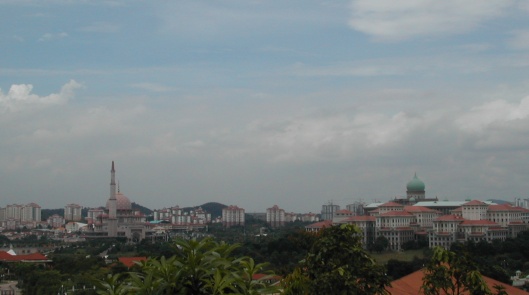
Putrajaya as seen from the Heritage Garden
Putrajaya is a planned community designed to serve as the federal government’s administrative center – similar to Washington DC in the US or Canberra in Australia. It is situated 12 miles south of the capital, Kuala Lumpur, in the state of Selangor. It is comprised of slightly more than 120,000 acres of former rubber and palm oil plantation, and there is a 1,000 acre lake in its center. There are nine bridges, and each is different. Each building is also different – most with markedly different architecture. However, the most impressive buildings are the Putra Mosque and the Perdana Putra.
The Putra Mosque is built of pink granite, and it can accommodate 15,000 worshipers at one time. Its highest point – the dome – is 2,500 feet above ground. There is substantial Islamic symbolism in many of its design features, and it is quite beautiful.
The Perdana Putra houses the offices of the Prime Minister, Deputy Prime Ministers, and many other government offices. It has one large dome surrounded by four smaller domes, and it is a landmark of Putrajaya.
Putrajaya is wired throughout with fiber-optics, and its schools are of the highest caliber in the nation. The projected population of Putrajaya is 350,000 with a workforce of more than half being public employees. Putrajaya is already a desirable place to live, and working for the government has never been so appealing. It is a very interesting concept.
This is the National Heritage Garden, and we stopped here for lunch. After lunch we took a tour, and it was a surprisingly good experience. The purpose of these gardens is to showcase the agricultural development of traditional Malaysian crops such as rubber, cocoa, palm oil, fruits, herbs, and spices. We saw many trees that were familiar in name but never previously seen – clove, allspice, rubber. We saw a rubber tree being tapped, and we were shown the rubber making process. The orchards and gardens themselves are on a hillside, and they were quite beautiful. They also offered some beautiful views over Putrajaya and the surrounding area. Our lunch stop became much more than we expected.
We were off to the big city for the afternoon. Although one could probably spend days in KL without seeing it all, we had just come from Singapore, and we were still on urban overload. An afternoon would be quite enough for us.
Kuala Lumpur means ‘muddy confluence’, and the city began at the confluence of the Klang and Gombak rivers in the mid-19th century. Tin prospectors were its first inhabitants, and it quickly became a rowdy boomtown. It was brought under control briefly, but it burned to the ground in 1881. It was rebuilt, and it became the capital of the Federated Malay States in 1896. It became a federal territory in 1974.
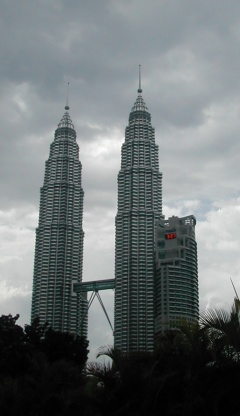
Petronas Towers
Because we were making only a quick visit, we decided to see the best known attractions of KL – the towers. KL is home to the twin Petronas Towers and the Menara KL (also known as the KL Tower).
The Petronas Towers, when first built in 1998, were the tallest buildings in the world. (Although they are no longer the tallest individual buildings, they are still the tallest ‘twin towers’.) There are two mirror-image towers, and each has 88 stories in its 1482 feet of elevation. The towers are connected by a ‘sky-bridge’ at the 41st and 42nd floors 558 feet above ground.
Visitors are allowed to go only to the 41st floor sky-bridge, and only 1400 visitors are allowed to visit each day. To get tickets, one needs to get in line by 6:00 in the morning on the day they want to visit. This was not for us.
We went to the Menara KL – more commonly called the KL Tower. The KL Tower is the fourth tallest communication tower in the world at 1381 feet. It is also situated on Bukit Nanas (Pineapple Hill), so it seems even taller than it is. One can visit the viewing deck at 905 feet above ground. This is hundreds of feet higher than the sky-bridge at the Petronas Towers, and the hillside location brings it up close to the top of the Petronas Towers.
The viewing area has a fabulous 360 degree view of the city. There are 12 ‘stations’ with photographic keys identifying landmark areas and structures within that 30 degree arc. One can also get an audio headset with a ‘guided tour’ of sorts; however, there were some major malfunctions when we were there, and we were content with the views and keys. This was a great way to get an overview of the city.
Deepavali is a Hindu celebration. Hindus are a small minority in Malaysia; however, the Malaysians recognize and celebrate major occasions in all their varied religions. Deepavali is a month-long celebration that culminates on one night in November – our first full day in Port Dickson.
Deepavali is a ‘Festival of Lights’, and oil lamps are lit outside Hindu homes. These lights are in celebration of the mythical Rama defeating the evil King Ravana. These lights also invite Lakshmi, the goddess of wealth, in to one’s home because she will not enter a dark home. This is an important Hindu celebration.
We were invited to join a group that was having dinner at the home of YB Dato’ S. Sothinathan – the minister of environmental issues. He is Hindu, and his family hosted an open house during which more than 2,000 people had dinner. The atmosphere was festive, the food was good, and it was a good experience.
We had a very full day and evening, and we had been in town little more than 24 hours. But we still had to address our engine noise, so our tourist tendencies would be curbed for a while.
Our engine is the original Westerbeke installed when the boat was built in 1980. She gets lots of TLC and maintenance, and she rarely lets us down. But the water pump was tired. It was not yet leaking, but the bearings were shot.
Bud removed it and took it to the small local boat yard. The yard manager, Philip, shook his head in dismay and told us that he doubted he could find anyone to repair it, but he would try. He and Bud set off, and after a few dead ends, they found someone whom said he might be able to repair it.
Meanwhile we got on the internet and telephone, and we learned that we would have to have a replacement pump sent from the US if we could not repair this one. We started that process, but we did not have the pump shipped to us. Two days later, our old pump was returned to us rebuilt and ready to be reinstalled. Bud reinstalled it, and it is working perfectly. What a relief! We will still get the new pump and keep it on board as a spare, but we will not be held up in Port Dickson for an unknown time waiting on an international shipment.
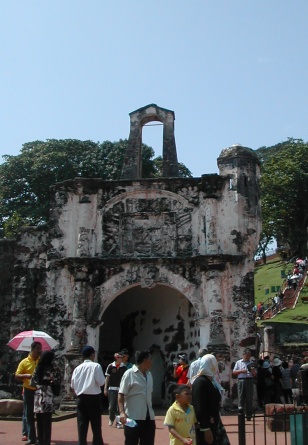
A’Famosa – the only Portuguese remains
Little problems kept cropping up and delaying our travel to visit historical Melaka. For a few days we doubted that we would be able to make the trip. However, persistence paid off, and we went for a day trip on November 16.
Melaka is a compact tour through Malaysia’s history. There are more Malays than Chinese in Melaka, but the most apparent ethnicity has been and remains Chinese. Melaka also provides reminders of Malaysia’s eras of colonization by the Portuguese, Dutch, and English. The Chinese are highly visible in Melaka. The Chinese influence on Melaka’s past is readily apparent, and today there is still an active and vibrant China town. We had an unexpected lesson in Chinese foot binding while in Melaka. We first met a delightful Chinese woman whose family has made shoes in Melaka for generations. She invited us in to her very old home and shared information on the gruesome history of foot binding. Later we met another shoemaker with a multigenerational history of shoemaking in Melaka, and he still makes and sells shoes (as souvenirs) from the patterns used generations ago – for 5 inch feet. Some of his pictures were difficult to look at. It is hard to imagine the pain endured by these women since they were little girls of three to four years of age.The Portuguese years in Melaka were almost lost over time. At present, the only standing relic from those years is the main gate to A’Famosa which was a fortress built in 1511. The maritime museum includes the Portuguese galleon – Flor De La Mar – that sank in the Straits of Melaka on its way to Portugal; however, this is a replica.
The Dutch years are readily apparent. The most obvious relic is Stadthuys. This was built in 1650 as the residence of the Dutch Governors and their officers, and it is exemplary of Dutch architecture of the time. Nearby is Christ Church which was built in 1753. This church has handmade pews, ceiling beams constructed without joints, and tombstones in the floor.
The English years are visible throughout town and beyond. Because the English were the most recent colonizers, remnants of their years in Melaka are most abundant.
There are numerous churches, mosques, and temples representing the various religions. There are numerous museums. There are also many cemeteries.
The tackiest things we saw were the trishaws – like rickshaws powered by a bicycle. These are throughout town and are used by locals as well as tourists. All of them are decorated with artificial flowers, and most have streamers and umbrellas. We called them the ‘flower children’, and no, we did not ride in one.
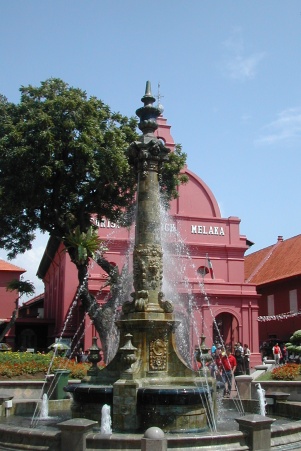
Dutch and English influence in Town Square
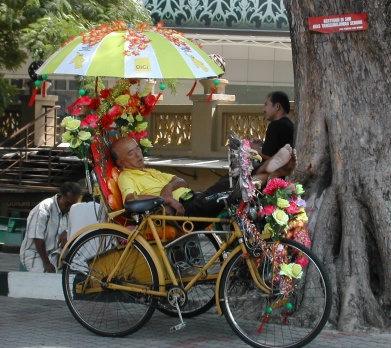
A tired flower child
It would be easy to spend three or four days exploring the history that abounds in Melaka. But we had only one day, so that is what we did. We are very glad that we spent a day there.
We had enjoyed our time in and around Port Dickson, but after visiting Melaka, it was time to continue northward. We left with plans to make a few island stops on our way to Pulau Pangkor then Penang. We left at sunrise on November 20.
Follow us as we sail to Penang or jump ahead to our stay in Penang or return to our Malaysia page.